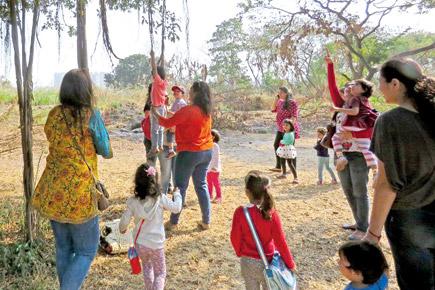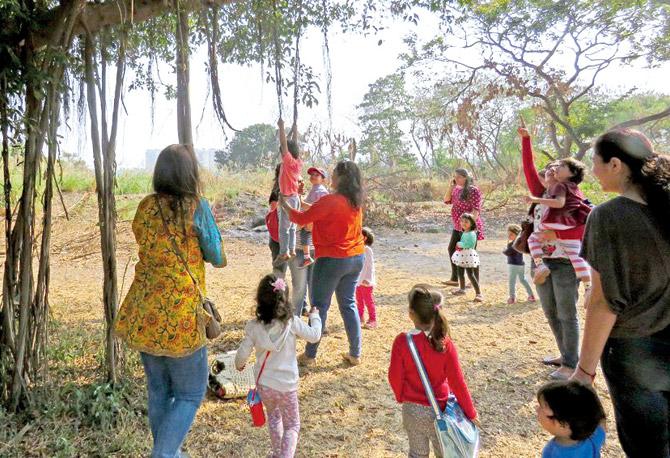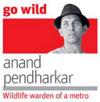One evening this week, I visited a friend's residence in JB Nagar, Andheri, and was surprised to find a bunch of teenagers playing football in the extended driveway. As we entered his building, we spotted four others playing badminton in the space behind the building

Kids connecting with nature in MNPS, Dharavi

Kids connecting with nature in MNPS, Dharavi
ADVERTISEMENT
 One evening this week, I visited a friend's residence in JB Nagar, Andheri, and was surprised to find a bunch of teenagers playing football in the extended driveway. As we entered his building, we spotted four others playing badminton in the space behind the building. It was 9.30 pm and a few women were walking along the tree-lined driveway and some senior citizens were chitchatting, resting on a series of benches in a mini-garden. Under the stilts of the various buildings, notwithstanding the parking area, there were many indoor games such as table-tennis, carom, chess and other board games, where over three dozen kids were thoroughly enjoying their Diwali vacations.
One evening this week, I visited a friend's residence in JB Nagar, Andheri, and was surprised to find a bunch of teenagers playing football in the extended driveway. As we entered his building, we spotted four others playing badminton in the space behind the building. It was 9.30 pm and a few women were walking along the tree-lined driveway and some senior citizens were chitchatting, resting on a series of benches in a mini-garden. Under the stilts of the various buildings, notwithstanding the parking area, there were many indoor games such as table-tennis, carom, chess and other board games, where over three dozen kids were thoroughly enjoying their Diwali vacations.
My first thought was, 'What a fantastic colony to live in'. But, then I asked my friend why the youngsters weren't playing on the larger mud-field that was placed on the farthest end of the colony. He took me and showed me the massacre that had been wrecked by the colony secretary, egged on by some disgruntled members. Around 20 trees, aged between 25 and 45 years, had been hacked to stumps and lay scattered all over the football field-sized playground. The area was dark and access was restricted by guards, due to the fear of the unknown (read snakes).
It's common to see colony playgrounds being converted into swanky clubhouses — with air-conditioned gymnasiums, a minibar-cum-restaurant, spa — under the garb of modernisation. What happens to the rights of children, youth and citizen who need open green spaces and the ability to be able to connect with nature, the outdoors and the soil? Were they even consulted before their rights were compromised and some concrete monstrosity was imposed onto them? The same scenario is repeated across Mumbai's urban green spaces, be it at Hanging Gardens, Race Course, Maharashtra Nature Park, Azad Maidan or the Aarey Milk Colony (AMC) which are under threat from infrastructure projects.
It's ironic that where AMC is concerned, the global community is celebrating and going gaga over the urban leopard photo clicked there by ace photographer Nayan Khanolkar, while our own government machinery seems bent on destroying this natural haven. Recent studies have indicated that Mumbai is one of the worst cities in the world to live in, with an open space index of 0.99m2 per person. While planning infrastructure or other heavy industries, we are brainwashed by giving comparisons with first world cities and their rate of urbanisation. However, we citizens don't aspire nor demand the same amount of open spaces per person as recommended by the WHO (9sq.m) or on the lines of cities such as Vienna (120m2), Singapore (66m2), Amsterdam (45.5m2), London (31m2), New York (26.4m2), Istanbul (6.4m2), Tokyo (3m2) and Buenos Aires (1.9m2). Even within Indian cities, Mumbai falls far behind when compared with Delhi (2.9m2), Kochi (2.5m2), Bangalore (1.9m2) or Ahmedabad (1.34m2).
Land use planners define urban open space as areas designated for parks, playing fields, highly maintained environments to relatively natural landscapes and in case of India, religious and socio-cultural interaction spaces too. National parks, sanctuaries, creeks, beaches, natural lakes and river beds should not be included in this calculation. And even among the maintained open spaces, it's not about the absolute presence of manicured gardens or parks, but about freely accessible spaces which are ecological habitats, and are suited for social, cultural, educational, recreational and the sports needs of a city.
Write to Anand at sproutsenvttrust@gmail.com
 Subscribe today by clicking the link and stay updated with the latest news!" Click here!
Subscribe today by clicking the link and stay updated with the latest news!" Click here!







